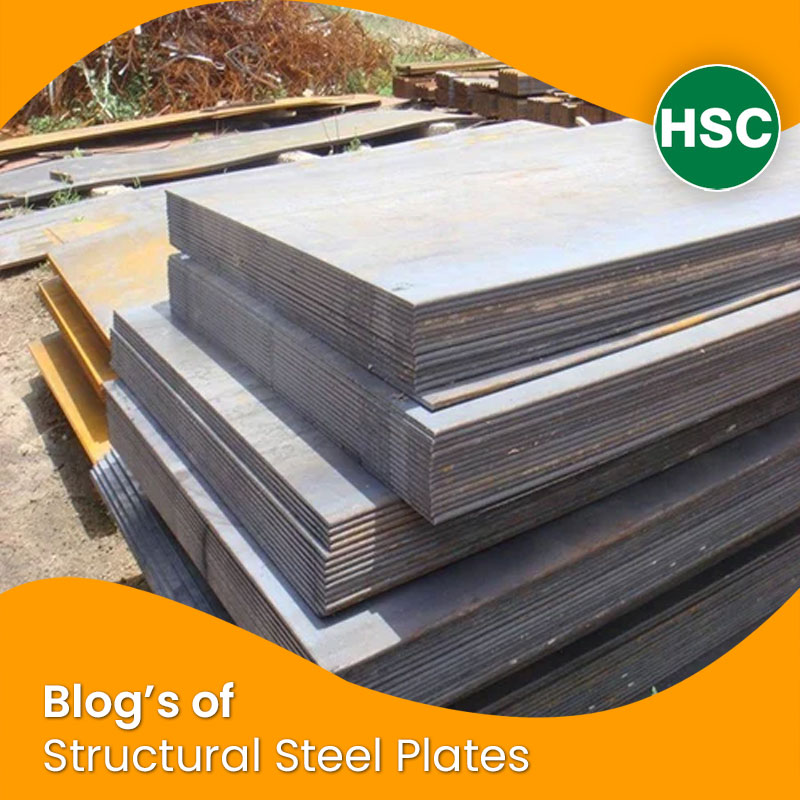Guide to Selecting Structural Steel Plates
Choosing the right structural steel plate is critical for the success of your project—whether you’re building a bridge, fabricating a telecom tower, or developing heavy machinery. At Hindustan Steel Corporation, we help buyers make informed decisions by understanding plate grades, applications, standards, and strength-to-weight ratios. This guide breaks down every key factor to simplify your purchase decision.
What Are Structural Steel Plates and Why Are They Used?
Structural steel plates are thick, flat rolled steel sheets designed for load-bearing applications in construction and industrial sectors. Known for their strength, ductility, weldability, and ease of fabrication, these plates form the backbone of modern infrastructure such as bridges, buildings, PEBs, ships, cranes, and towers.
Typical Use Cases for Structural Steel Plates
- Bridge and flyover construction
- PEB buildings and steel sheds
- Offshore oil platforms and marine barges
- Heavy fabrication machinery
- Railway wagons and support structures
- Wind towers and telecom infrastructure
- Cranes, dozers, and lifting equipment
Key Mechanical Properties to Evaluate
When selecting structural plates, assess the following:
- Yield Strength (MPa) – Ability to resist permanent deformation
- Tensile Strength (MPa) – Maximum stress before breakage
- Elongation (%) – Ductility/flexibility
- Impact Strength – Toughness under shock load
- Hardness – Resistance to wear and tear
- Thickness Tolerance – Accuracy for tight fabrication
How to Select the Right Structural Steel Grade?
Here’s how you can decide based on strength, environment, and standards:
| Application | Recommended Grades |
|---|---|
| General construction | IS 2062 E250 / E350 / EN 10025 S235JR |
| Bridges, marine | S355J2 / A36 / DIN St52 / P355NH |
| Heavy equipment | SAILMA E450 / E550 / JFE Hiten 780LE |
| Offshore, extreme climate | A572 Gr 50 / S355J2+N / NAXTRA 70 |
Tip: For export compliance, match local standards with global equivalents (e.g., A36 vs S355 vs IS 2062).
Which Standards to Consider When Selecting?
You should consider both national and international standards like:
- IS 2062 (India)
- EN 10025 (Europe)
- ASTM A36 / A572 (USA)
- JIS G3101 SS400 (Japan)
- DIN 17100 St52 / St37 (Germany)
- GOST 380-94 St3 (Russia)
Always cross-check equivalents and certifications.
Choosing the Right Thickness & Width
- Common thickness range: 6 mm to 150 mm
- Widths available: 1250 mm to 3000 mm
- Lengths: Custom cut to 12,000 mm or more
Decide based on project span, load-bearing requirements, and fabrication ease.
When to Choose High Tensile Plates?
Choose high tensile grades like SAILMA, JFE Hiten, or NAXTRA when:
- You need higher load capacity with less weight
- You’re designing crane booms, chassis, or tall towers
- You want to save weight and cost in transportation
Custom Fabrication or Profile Cutting Tips
At Hindustan Steel Corporation, we offer:
- Cut-to-length processing
- Plasma/Oxy profile cutting
- CNC bending and forming
- Shot blasting and painting
Choose profiles (rectangular, trapezoid, arc) that minimize scrap and reduce welding load.
Why Hindustan Steel Corporation Is Your Best Partner?
- 40+ years of experience in plate solutions
- Ready stock of all grades including S355J2, IS 2062, and SAILMA
- Cut-to-length, mill TC, IBR-certified, and export-ready
- Fast delivery across India and 6+ countries
- Dedicated support for fabricators and EPC contractors
Export Guidance for Overseas Structural Projects
If exporting to UAE, Africa, or Southeast Asia:
- Match EN 10025 or ASTM norms
- Ensure 3.1 MTC + Test Certificates
- Look for sea-worthy packing
- Choose Hindustan’s Indian alternatives to A36 / S355 for better cost-efficiency.
Buyer Tips for First-Time Structural Plate Buyers
- Never compromise on grade and test certificate
- Check for UT test, Charpy impact value, and bend test
- Avoid over-specifying—consult engineers to optimize thickness
Choose pre-cut profiles to save fabrication time
Certifications You Should Ask Before Ordering
- Mill Test Certificate (MTC 3.1 or 3.2)
- IBR or PED Approval (if for pressure applications)
- ISO 9001 Quality Management
- BIS IS 2062 Standard Approval
15 FAQs – Guide to Selecting Structural Steel Plates
Which grade is best for heavy construction?
S355J2 or IS 2062 E350/E450 are ideal for bridges and PEBs.
How do I choose between A36 and IS 2062?
A36 follows ASTM standards, IS 2062 is Indian. Match based on specs
Is SAILMA better than EN 10025?
SAILMA is a high-strength alternative with excellent weldability.
Which plate is used for crane fabrication?
JFE Hiten, SAILMA 550, or NAXTRA 70 are preferred.
How to ensure weldability of structural plates?
Look for low carbon equivalent (CE) and request weld test data
Can I use high tensile plates for marine?
Yes, but choose grades with Charpy impact rating at low temp (e.g., -20°C)
What does E250 or E350 mean in IS 2062?
It refers to yield strength—250 MPa or 350 MPa respectively.
Are these plates available rust-protected?
Yes, we offer shot-blasted and painted options on request.
What are Indian alternatives to S275 or S355?
IS 2062 E250 and E350 serve as equivalents
What thickness range is ideal for telecom towers?
8 mm to 25 mm is common based on structural load.
How does structural plate differ from boiler plate?
Structural plates are for strength and fabrication; boiler plates handle pressure
What is the minimum order quantity (MOQ)?
We supply even 1 plate or full truckloads—customized to your project
Can I request CNC profile cut parts?
Yes, we offer precision cutting as per your CAD drawings
Do you export to the Middle East or Africa?
Yes, with mill certification and port-to-port delivery.
How quickly can I get delivery in India?
Most orders are dispatched within 1–2 days from stock
Let our technical advisors guide you to the most cost-effective, performance-matched plate.

